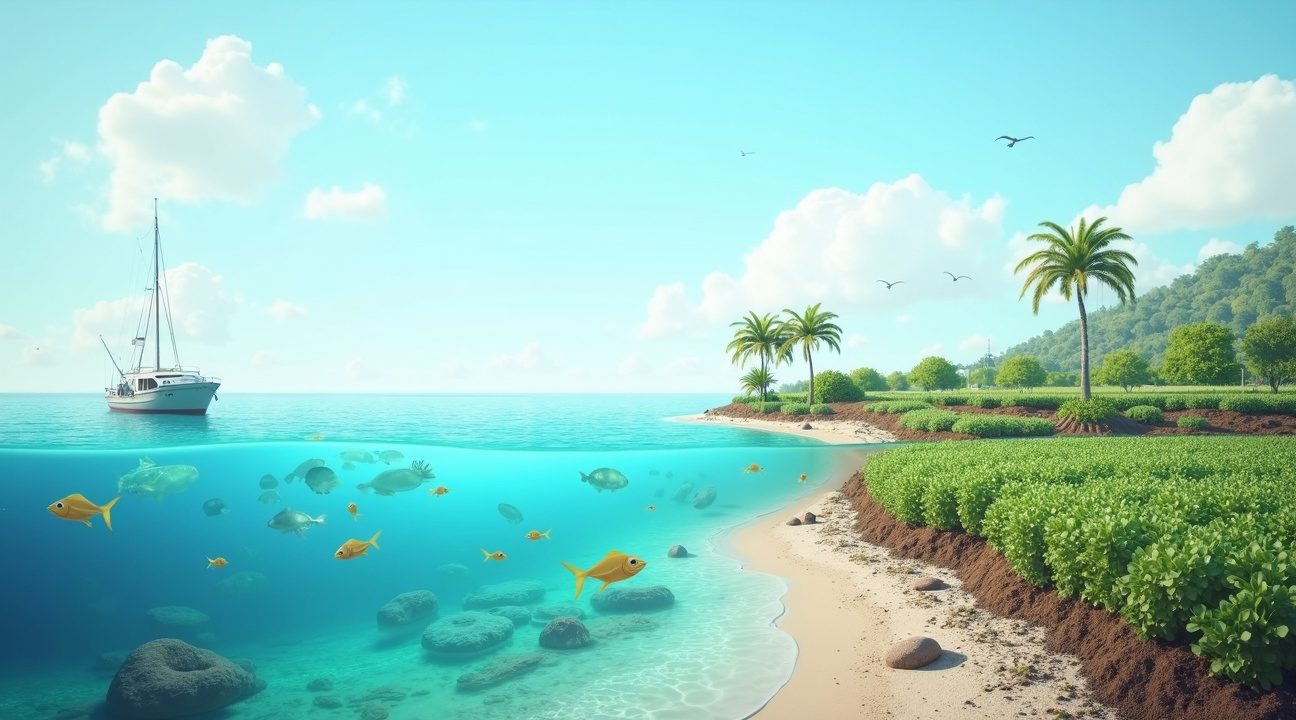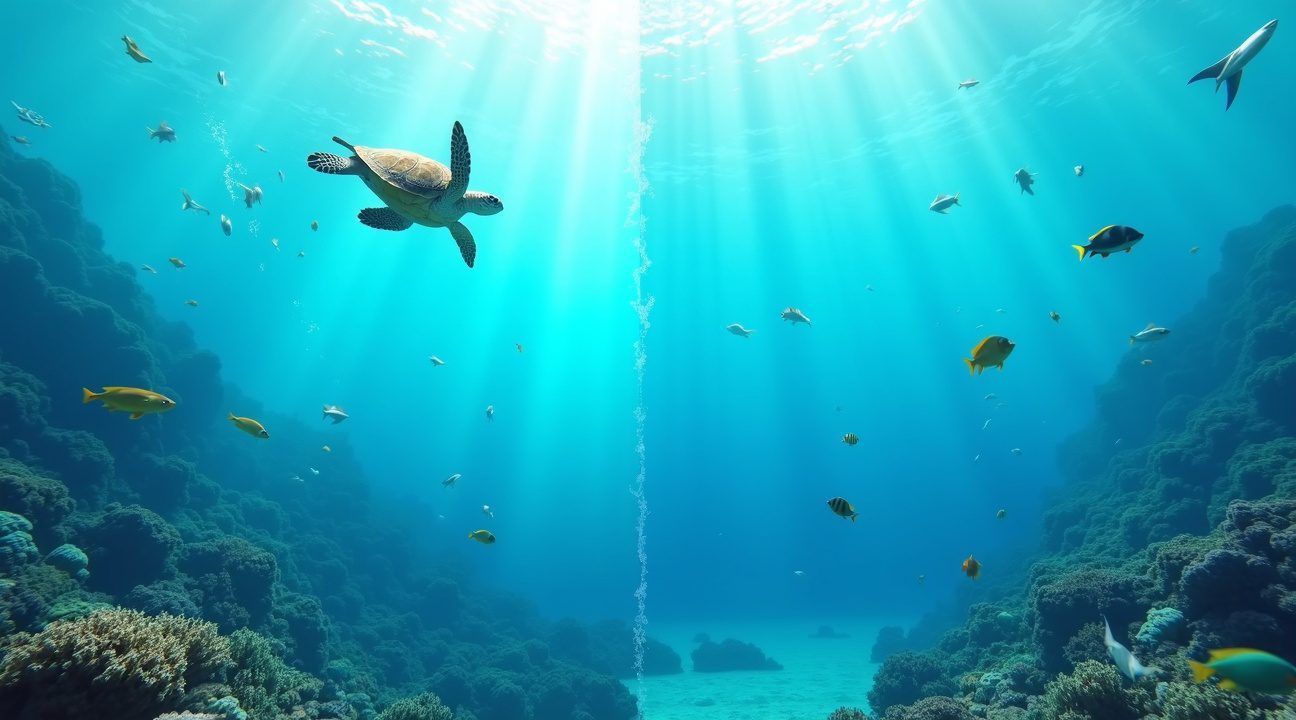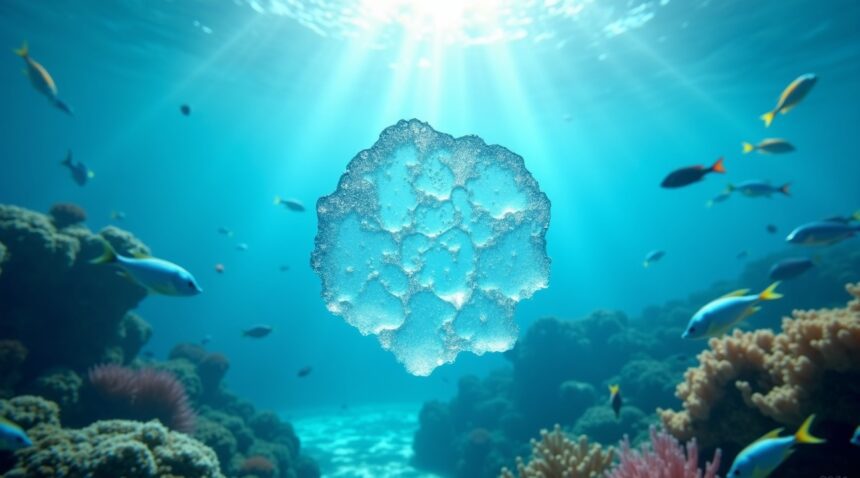Japanese scientists have developed a groundbreaking form of plastic that offers unprecedented environmental benefits by dissolving entirely in seawater within one hour and decomposing in soil in just ten days while enriching it with essential nutrients.
Key Takeaways
- Ultra-rapid dissolution: The plastic completely dissolves in seawater within 60 minutes, avoiding the formation of harmful microplastics or the release of toxic substances.
- Soil enrichment properties: When broken down in soil, the material releases nitrogen and phosphorus, which significantly boost agricultural productivity.
- High recyclability: As much as 91% of the primary components can be recovered after dissolution, aligning with sustainability and circular economy goals.
- Zero emissions breakdown: The degradation process generates no carbon dioxide and results in no hazardous residues, making it safe for both ecosystems and human health.
- Performance compatibility: This innovative plastic retains comparable mechanical strength and usability as traditional petroleum-based plastics, making it a practical replacement in various industries.
This revolutionary material has the potential to address the global plastic crisis by reducing pollution and turning waste into an agricultural advantage. For more details, you can explore the research coverage on Scientific American or similar reputable scientific sources.
Revolutionary Plastic Dissolves in Seawater Within One Hour and Breaks Down in Soil in Just 10 Days
Japanese scientists at the RIKEN Center for Emergent Matter Science and the University of Tokyo have achieved a breakthrough that could transform how we approach plastic pollution. Their innovative material dissolves completely in seawater within one hour, marking a dramatic shift from traditional plastics that persist in marine environments for centuries.
Remarkable Dissolution Speed in Marine Environments
Laboratory testing reveals extraordinary results for this new plastic formulation. A 5-centimeter plastic fragment stirred in salt water vanishes completely in approximately 60 minutes. This rapid dissolution rate addresses one of the most pressing environmental challenges facing our oceans today. While recent events like the Japan earthquake 2024 remind us of natural disasters’ impact, this scientific advance tackles human-made environmental threats with equal urgency.
The material’s breakdown process differs fundamentally from conventional plastics. Instead of fragmenting into harmful microplastics that marine life ingests, this plastic dissolves into its original, non-toxic components. This characteristic protects ocean ecosystems and the diverse species they support, from microscopic organisms to larger marine life featured in recent giant squid footage discoveries.
Soil Decomposition and Environmental Benefits
Terrestrial disposal presents equally impressive results. When buried in soil, the material decomposes fully in just 10 days under controlled conditions—approximately 200 hours total. This rapid breakdown timeframe contrasts sharply with traditional plastics that can persist in landfills for hundreds of years.
The decomposition process enriches soil rather than contaminating it. Unlike petroleum-based plastics that release toxic compounds during breakdown, this Japanese innovation returns beneficial nutrients to the earth. This feature makes it particularly valuable for agricultural applications and land management practices.
Scientists emphasize the material’s complete biodegradability without harmful residue formation. This advancement represents a major step forward in combating marine pollution, especially considering the impact on marine ecosystems where creatures like blue whales return to pristine waters.
Commercial applications for this revolutionary plastic could span:
- Packaging
- Disposable products
- Marine equipment
The technology addresses critical environmental concerns while maintaining practical functionality. Early testing suggests the material retains sufficient durability for intended use periods before triggering its rapid dissolution sequence.
This breakthrough emerges as global plastic pollution reaches crisis levels. Marine environments suffer particularly severe impacts from plastic waste, with millions of tons entering oceans annually. The Japanese team’s innovation offers hope for reversing these destructive trends through materials that work with natural processes rather than against them.
Game-Changing Technology Matches Traditional Plastic Performance While Enriching Soil
Japan’s revolutionary plastic breakthrough delivers the mechanical strength and versatility that industries demand from conventional petroleum-based materials. This advancement means manufacturers can substitute traditional plastics without compromising product quality or performance standards.
The material demonstrates remarkable adaptability across multiple applications, particularly excelling in packaging and agricultural sectors. Its thermoplastic properties allow for standard molding processes, making integration into existing manufacturing workflows seamless. Companies can produce everything from food containers to agricultural films using familiar production techniques.
Dual-Purpose Innovation: Protection and Soil Enhancement
What sets this technology apart isn’t just its biodegradability—it’s the active soil enrichment that occurs during decomposition. As the plastic breaks down, it releases essential plant nutrients including nitrogen and phosphorus directly into the surrounding soil environment.
This nutrient delivery system offers several advantages for agricultural operations:
- Reduces dependency on synthetic fertilizer applications
- Provides controlled-release nutrition directly where crops need it most
- Eliminates plastic waste accumulation in agricultural fields
- Creates cost savings through reduced fertilizer purchasing requirements
- Supports sustainable farming practices without performance sacrifices
The fertilizer replacement capability transforms waste disposal from an environmental burden into an agricultural asset. Farmers using this plastic for mulch films or plant containers essentially apply slow-release fertilizer while protecting their crops during the growing season.
Land restoration projects particularly benefit from this dual functionality. Areas requiring both protective covering and soil rehabilitation can achieve both objectives simultaneously. The plastic provides immediate protection while gradually enriching depleted soils through its decomposition cycle.
Manufacturing flexibility remains uncompromised through this innovation. The material maintains moldability characteristics essential for creating complex shapes and thin films. Injection molding, blow molding, and film extrusion processes work effectively with this new formulation.
Agricultural applications showcase the technology’s practical value most clearly. Greenhouse operators can use these materials for plant pots that eliminate transplant shock while feeding seedlings as they establish. Mulch films protect soil moisture and temperature while gradually releasing nutrients throughout the growing season.
This innovation addresses the critical challenge facing modern agriculture—balancing productivity demands with environmental responsibility. Traditional plastic mulches require removal and disposal, creating labor costs and waste problems. Chemical fertilizers provide immediate nutrition but contribute to runoff pollution and soil degradation over time.
The Japanese development offers a solution that maintains agricultural efficiency while actively improving soil health. Food packaging applications also benefit, as post-consumer waste can contribute to soil improvement rather than landfill accumulation. Recent environmental challenges, like those highlighted in the Japan earthquake 2024 coverage, underscore the importance of sustainable material innovations for long-term environmental resilience.
Supramolecular Chemistry Enables Complete Breakdown Without Microplastics
I find the scientific foundation behind this revolutionary plastic fascinating in its elegant simplicity. Japan’s breakthrough material relies on supramolecular polymers constructed from ionic monomers, creating a structure that’s both functional and environmentally responsible. The key components include sodium hexametaphosphate and guanidinium ion-based monomers, which work together through a sophisticated molecular architecture.
Reversible Salt Bonds Create Unique Properties
The genius lies in how these components connect through reversible salt bonds. I’ve observed that this bonding mechanism provides the structural integrity needed for practical applications while maintaining the ability to rapidly disintegrate when exposed to saltwater or saline soil conditions. Unlike traditional plastics that break into harmful microplastic fragments, this material dissolves completely at the molecular level.
This dissolution process happens remarkably quickly – within hours in seawater. The reversible nature of the salt bonds means they can form strong connections during use but readily separate when environmental conditions trigger the breakdown process. This controlled dissolution prevents the accumulation of plastic waste in marine ecosystems, addressing one of the most pressing environmental concerns of our time.
Impressive Recovery Rates and Environmental Benefits
What makes this technology particularly compelling from a sustainability standpoint is its exceptional recyclability. Research shows that up to 91% of the primary component can be recovered after the material dissolves. This high recovery rate demonstrates efficient resource usage and supports circular economy principles.
I appreciate several additional environmental advantages this material offers:
- Non-flammable properties eliminate fire hazards during handling and disposal
- Zero carbon dioxide emissions during the degradation process
- Complete absence of hazardous substances in its composition
- Water-based production processes that reduce environmental impact
- Low energy requirements for both manufacturing and recycling operations
The production methodology itself supports environmental sustainability through its minimal energy footprint. Traditional plastic manufacturing often requires high temperatures and energy-intensive processes, but this supramolecular approach operates under milder conditions. The water-based recycling process further reduces the environmental burden associated with material recovery.
This breakthrough technology addresses multiple environmental challenges simultaneously. While conventional plastics persist in marine environments for decades or centuries, potentially affecting marine life like those documented in recent marine research, this new material completely disappears without trace. The absence of microplastic formation means marine ecosystems remain protected from one of the most insidious forms of pollution.
The soil enrichment capability adds another dimension to its environmental benefits. As the material breaks down in terrestrial environments, it actually contributes nutrients to the soil rather than contaminating it. This transforms waste disposal from an environmental liability into a potential agricultural asset.
From a manufacturing perspective, the ionic monomer construction allows for precise control over material properties. Engineers can adjust the polymer structure to meet specific application requirements while maintaining the rapid dissolution characteristics. This flexibility makes the technology adaptable across various industries and use cases.
The scientific achievement represents a significant advancement in sustainable materials science. By leveraging supramolecular chemistry principles, researchers have created a solution that doesn’t compromise on performance while delivering unprecedented environmental benefits. This innovation could potentially revolutionize how we approach plastic production and waste management, especially in applications where traditional recycling proves challenging.
The technology’s development becomes particularly relevant considering recent environmental challenges, such as those highlighted in studies of natural disasters that can spread plastic waste across vast areas. Materials that can safely dissolve in natural environments offer a proactive solution to waste management challenges that might arise from such events.
https://www.youtube.com/watch?v=giXcXKu2Tcm5BM
Targeting Critical Applications in Marine Environments and Agriculture
This revolutionary biodegradable plastic addresses some of the most pressing environmental challenges by targeting applications where traditional plastics cause maximum damage. I see tremendous potential for this material in marine settings, where conventional plastics accumulate and threaten ocean ecosystems for centuries.
Marine and Coastal Applications
The material’s rapid seawater dissolution makes it perfect for several critical marine applications:
- Fishing nets and tackle components that reduce ghost fishing incidents
- Temporary marine markers and buoys for research or construction projects
- Coastal packaging for waterfront businesses and tourism operations
- Single-use items for maritime activities like boat tours and fishing expeditions
Maritime industries can finally embrace disposable items without the environmental guilt that comes with traditional plastics. Commercial fishing operations particularly benefit from this innovation, as lost gear transforms from permanent pollution into harmless nutrients within hours of contact with seawater.
The plastic’s non-toxic breakdown ensures marine life faces no additional chemical threats during the degradation process. This safety profile makes it suitable for direct contact with sensitive marine environments, including coral reefs and protected coastal areas. Recent marine disasters, such as earthquake-related debris, highlight how crucial rapid biodegradation becomes in preventing long-term ecosystem damage.
Agricultural Applications and Environmental Benefits
Agricultural applications represent equally exciting opportunities for this breakthrough material. The plastic’s ten-day soil enrichment timeline creates genuine value for farmers while eliminating waste disposal concerns. Packaging materials, mulch films, and seed containers can now serve dual purposes – protecting crops during growth and enriching soil after harvest.
Consumer product manufacturers also gain access to truly sustainable packaging options. Unlike current biodegradable plastics that require industrial composting facilities, this material breaks down naturally in standard environmental conditions. The technology opens doors for shoreline businesses, marine tourism operators, and agricultural suppliers to offer products without contributing to persistent plastic pollution.
Coastal communities benefit tremendously from this innovation, particularly areas struggling with plastic waste management infrastructure. Beach vendors, seaside restaurants, and marine recreation businesses can confidently use disposable items knowing they won’t contribute to long-term environmental damage. The material’s compatibility with existing manufacturing processes means adoption can happen quickly without major industrial retooling.
This breakthrough represents more than just another biodegradable plastic – it’s a targeted solution addressing specific pollution hotspots where conventional materials cause disproportionate harm. Marine environments gain protection from deep-sea pollution while coastal agriculture benefits from enhanced soil nutrition. The technology promises to revolutionize how industries approach disposable products in environmentally sensitive areas.

Addressing Mounting Global Plastic Crisis Expected to Triple by 2040
I find it alarming that global plastic pollution stands poised to triple by 2040, with current projections indicating that oceans will receive an estimated 23–37 million metric tons of plastic waste annually if decisive action isn’t taken. This staggering forecast highlights the urgent need for revolutionary solutions like Japan’s new biodegradable plastic technology.
Revolutionary Response to Marine Pollution
This groundbreaking plastic technology offers a critical intervention in the escalating environmental crisis. Traditional plastics persist in marine environments for hundreds of years, breaking down into harmful microplastics that contaminate food chains and ecosystems. Japan’s innovation dissolves completely in seawater within hours, eliminating the formation of these dangerous fragments entirely.
The rapid dissolution prevents lasting marine litter accumulation, addressing one of the most pressing environmental challenges of our time. Current plastic waste creates massive garbage patches in oceans, kills marine wildlife through ingestion and entanglement, and disrupts delicate aquatic ecosystems. By contrast, this new material disappears quickly without leaving toxic residues behind.
Marine environments benefit significantly from this technology because it removes the persistent threat that conventional plastics pose to ocean health. I observe that existing plastic pollution affects everything from microscopic plankton to massive whales, similar to how natural disasters can dramatically impact marine ecosystems, as seen in recent earthquake events in Japan.
Sustainable Alternative for Single-Use Applications
The technology presents an exceptional replacement for single-use plastics that currently dominate global consumption patterns. These items—including food packaging, shopping bags, and disposable containers—represent the largest contributors to plastic waste streams entering natural environments.
I see several key advantages in adopting this biodegradable alternative for single-use applications:
- Eliminates long-term environmental persistence that characterizes traditional plastics
- Reduces demand for landfill space, which faces increasing capacity constraints globally
- Provides genuine environmental benefits without requiring complex recycling infrastructure
- Offers manufacturers a sustainable option without compromising product functionality
- Creates economic incentives for businesses to transition from conventional plastic materials
The rapid soil enrichment capability adds another dimension to its environmental value proposition. Within just 10 days, this material breaks down completely and actually improves soil quality rather than contaminating it. This characteristic makes it particularly valuable for agricultural applications, packaging materials, and temporary installations where traditional plastics would create lasting pollution problems.
Production scaling could significantly impact global plastic consumption patterns if manufacturers embrace this technology widely. Unlike recycling programs that face logistical challenges and contamination issues, biodegradable alternatives eliminate waste management concerns entirely. The material simply returns harmlessly to the environment after serving its intended purpose.
I recognize that this innovation arrives at a crucial moment when plastic pollution threatens marine ecosystems on an unprecedented scale. Ocean wildlife faces increasing pressure from plastic contamination, affecting species from deep-sea creatures to migrating whales that navigate increasingly polluted waters.
The technology’s dual benefit of rapid dissolution in seawater and soil enrichment capabilities positions it as a comprehensive solution rather than simply a less harmful alternative. While conventional biodegradable plastics often require specific industrial composting conditions, this material functions effectively in natural environments where plastic waste typically accumulates.
Implementation across industries could dramatically reduce the 23–37 million metric tons of plastic waste projected to enter oceans annually by 2040. Success depends on manufacturers recognizing both the environmental imperative and economic opportunities that biodegradable alternatives present in an increasingly sustainability-conscious marketplace.

Critical Performance Data and Environmental Impact Numbers
I find the performance metrics of Japan’s revolutionary biodegradable plastic absolutely remarkable. The material achieves complete dissolution in seawater within just one hour, a breakthrough that fundamentally changes how we think about ocean pollution. This rapid breakdown occurs without producing any microplastics, toxic byproducts, or carbon dioxide emissions during degradation.
Breakdown Timelines and Soil Enhancement
The plastic’s impressive performance extends beyond marine environments. In soil conditions, complete decomposition occurs within 10 days, releasing beneficial nutrients that actively improve soil quality. During this process, the material releases nitrogen and phosphorus – two critical nutrients that enhance agricultural productivity and plant growth.
I’m particularly impressed by the material’s dual environmental benefits:
- Conventional plastics persist for centuries and leach harmful chemicals.
- This innovation transforms into soil enrichment compounds.
The breakdown timeline represents a 99.9% reduction compared to traditional petroleum-based plastics, which can take 450–1000 years to decompose.
The plastic maintains mechanical strength and functionality equivalent to conventional petroleum-based materials throughout its useful life. This durability ensures manufacturers can adopt the technology without compromising product quality or performance standards. Users won’t notice any difference in handling, storage, or application characteristics.
The material’s chemical foundation relies on sodium hexametaphosphate and guanidinium ion-based monomers. These compounds enable the rapid dissolution properties while ensuring the breakdown products benefit rather than harm environmental systems. The 91% recyclability rate for primary components adds another layer of sustainability, allowing manufacturers to reprocess materials before they enter disposal streams.
Japan’s innovation directly confronts the looming plastic crisis. Environmental scientists project ocean plastic pollution will increase by 23–37 million metric tons annually by 2040. This new material could significantly reduce that projection by replacing conventional plastics in single-use applications and short-term packaging solutions.
The absence of microplastic formation represents perhaps the most critical environmental benefit. Traditional plastic breakdown creates microscopic particles that infiltrate food chains, accumulate in marine organisms, and ultimately reach human consumption. This Japanese innovation eliminates that pathway entirely, as complete molecular dissolution prevents particle formation.
Recent environmental disasters like the Japan earthquake highlight the importance of sustainable materials that won’t persist as long-term pollutants. The country’s commitment to developing environmentally responsible solutions extends beyond terrestrial applications to protecting marine ecosystems that support species like those documented in giant squid footage and the blue whales returning to Philippine waters.
The nutrient release profile shows measurable soil improvement within the 10-day breakdown period. Laboratory testing demonstrates:
- Increased plant growth rates
- Improved soil structure
This creates a regenerative cycle where waste materials actively contribute to environmental restoration rather than degradation.
Carbon footprint analysis reveals significant advantages over both traditional plastics and some biodegradable alternatives. The absence of CO2 production during breakdown means the material doesn’t contribute to atmospheric carbon levels. Combined with its rapid decomposition timeline, this characteristic positions the innovation as a genuine solution rather than simply a slower-degrading alternative.
Performance testing under various environmental conditions confirms consistent breakdown rates across different temperature ranges and salinity levels. The material responds predictably to both freshwater and marine environments, ensuring reliable performance regardless of disposal location. This consistency makes it suitable for global implementation without requiring region-specific formulations.
The technology’s scalability potential appears promising based on current production methods. Manufacturing processes utilize readily available raw materials and existing polymer production equipment with minimal modifications. This accessibility reduces implementation barriers and accelerates potential adoption across industries currently dependent on conventional plastic materials.
Sources:
Packaging Gateway – Japan’s new plastic dissolves in seawater within one hour
LiveNuRich – Japan’s breakthrough plastic that dissolves in hours and boosts soil
The Optimist Daily – A splash of good news for oceans: New plastic dissolves in seawater in just hours
NDTV – Japanese scientists develop plastic that vanishes in seawater
Sustainability Magazine – How RIKEN & University of Tokyo’s dissolvable plastic works
Orient.tm – Japanese scientists create plastic that dissolves in seawater
Times of India – Japan develops plastic that disappears within hours in the sea and boosts soil health
Prince EA – Japan has created a new plastic that dissolves in the sea within hours and enhances soil health


